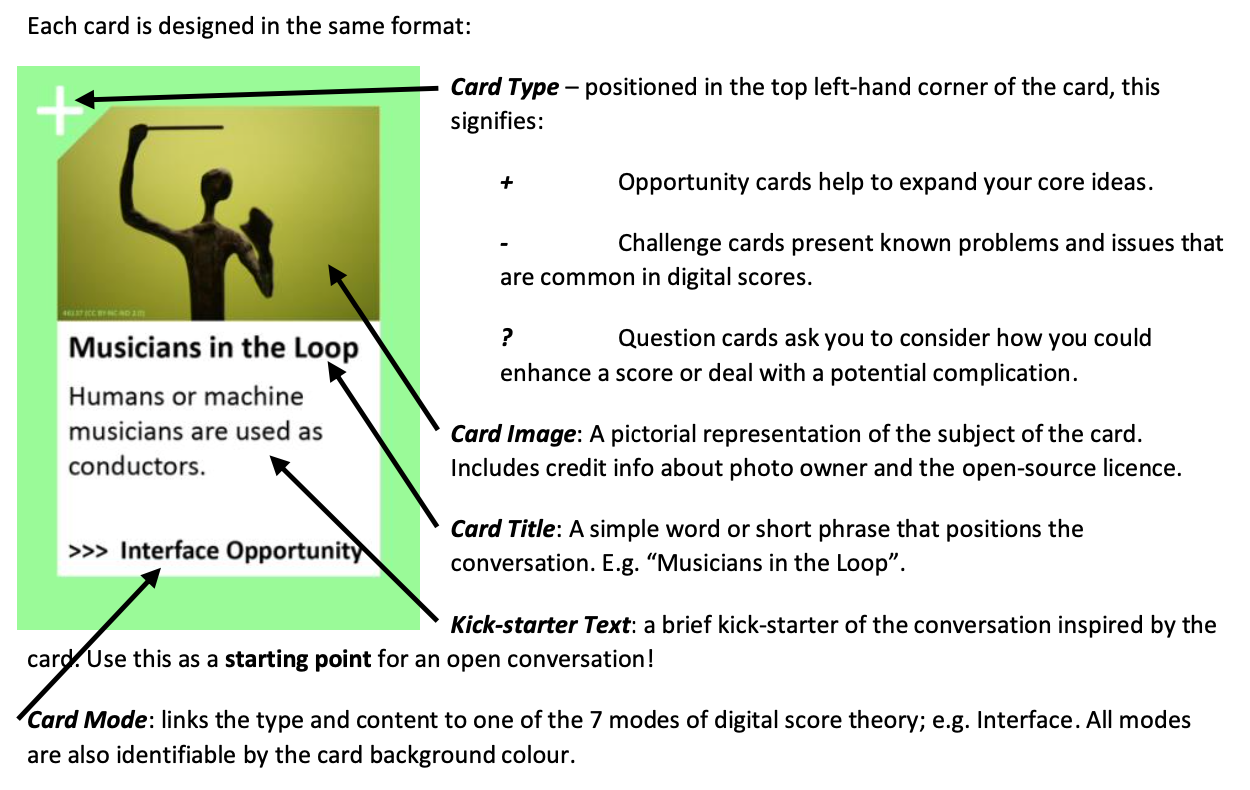The Digital Score Creativity Cards
These cards have been created to help you design, develop and create digital scores. They present insights from different perspectives on the possibilities, opportunities, challenges and questions around the creation of a digital score. They have been designed to operate like a conversation between you, your creative ideas, and the wealth of experience from those who have researched and specialise in making digital scores. The hope is that they offer new ways of thinking, creating, performing and sharing your musical ideas in the 21st Century.
| Cards can be downloaded here https://digiscore.github.io/assets/cards/creativity_cards.zip
What is a digital score?
Simply put a digital score is much like a traditional music score: it is a communications package of a musical idea that is sharable. However, digital scores use the creative potential of technology to expand on the types of musical ideas that can be shared and expressed as a music score.
They are the next evolutionary step of the traditional paper-based score. But instead of being limited to a piece of paper (or PDF) as the “package” with which a musical idea is shared or being restricted by the limitations of printing press technology, a digital score benefits from the creative potential of all technologies. So if you want to explore animated scores where the notation moves about on a screen, or you want the digital score to be like a computer game where player interaction is key, or you wish to explore robotics or AI, then these digital score creativity cards can help you package your musical idea in such a way that it is communicated to other musicians, again and again.
Notation vs The Language of a Score
A traditional score is more than just the notation printed on it. Reading from Bach’s original handwritten manuscript is a vastly distinct experience from reading those same notes from a version created in Sibelius: same notes, different platforms, different worlds, different meanings. With a digital score, we must address our own tendencies to think of a score as being solely about the notation. Notation is an important symbol-based mechanism with which certain musical ideas can be expressed and presented to other musicians. But when we are creating digital scores we have access to all sorts of media, all sorts of technology, and all sorts of senses (eyes, ears, touch etc.). And crucially it allows all sorts of musicians the opportunities to express their musical ideas in a way of their choosing.
Common notation is a useful symbol system used by millions of musicians around the world, for many, many years. But if your musical idea can’t be expressed with static notes on a stave, or it is too complex to anchor onto a fixed page, or the musicians you are working with do not read common notation, or you want to express contemporary ideas in way that adopts contemporary culture and technology, or you want to explore AI agents or gaming interactivity then a new system of language will be needed — one that allows you to express your idea in a score, and this may be a new form of notation, but equally it could be colours, shapes, sounds, pre-recorded instructions, data visualisations, dancing robots or AI improvising partners.
“A music language defines what you can say; what you want to say defines your music language” Cornelius Cardew.
“To Imagine a language is to imagine a form of life; the limits of my language are the limits of my world” Ludwig Wittgenstein.
The Card’s Design

Open conversations with the cards
We would like to think that these cards encapsulate a lot of our knowledge about creativity in, with and through digital scores. Therefore, we hope that each card presents a part of our knowledge for you to use as a conversation point about your digital score. You might find that through these conversations your ideas have become enhanced or transformed. You might find that it presents a certain challenge that you hadn’t considered and can now discuss with yourself or your team. You might find that the conversation is seemingly irrelevant to your idea; but do discuss it and then discard it. There is no right or wrong here, but we do ask that you enter an open conversation and that you allow your ideas to grow, transform, adapt, change and become enhanced.
Acknowledgements
The DigiScore team would like to thank Richard Wetzel for his inspiration and support with these cards. His Mixed Reality Game Cards directly informed the design of these creativity cards, and some of its content. Wetzel, Richard, Tom Rodden, and Steve Benford. “Developing Ideation Cards for Mixed Reality Game Design.” Transactions of the Digital Games Research Association 3, no. 2 (2017). https://doi.org/10.26503/todigra.v3i2.73.